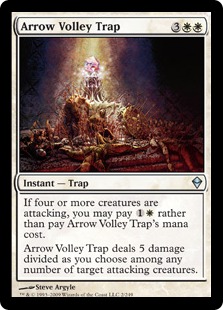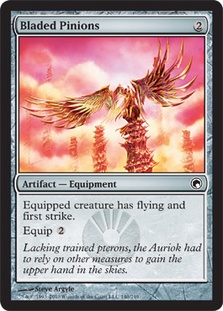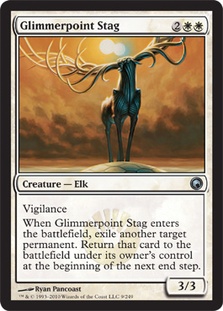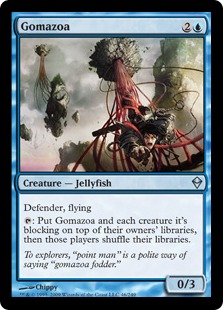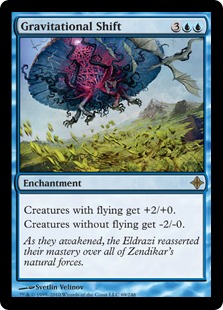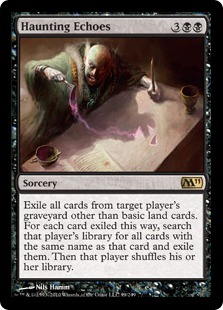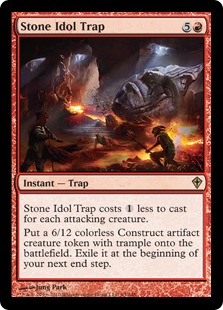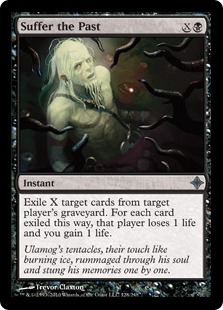The best way to win at Magic is however your inclinations and intuitions so incline and intuit. Why? Because:
Magic isn’t a game; it’s rules to govern several games played with the same pieces.
In other words, having so many cards as options lets you choose the pieces of the game, and by choosing certain pieces over others, you’re dictating the object of the game as well. Winning with mill is different than winning with twenty aggro damage, twenty burn damage, twenty damage from finishers after you’ve exhausted the opponent’s resources, poison, or Felidar Sovereign. Each one states a different object, uses different pieces, and reflects on your view of Magic.
For me, and I suspect for the vast majority of you, those views come from other games and other places, strategies that were right for the things you were good at. These strategies focus your goals when you get to the much bigger, much more customizable game of Magic, and how you define those goals optimizes your ability to play certain archetypes and keeps you from understanding others. It’s normal and inescapable, and the more you understand your motivations in other areas, the more you’ll gain perspective on your Magic.
Guided by connections to an odd bunch of celebrities, whether directly or a Bacon number away, I’ve figured out the best way for me to win. In giving advice from my process and my perspective, I’m intending for you to write your own article in a sense. What games and experiences have you pulled from? What’s the best way to win for you? Whether you adopt my ideas or not, if I’ve helped you trace and develop your ideas better, then I’ve done what I wanted to do. So here I go, organized by celebrity…
Andy Dick
In 1965, a boy was adopted by Dycks. With time and a new spelling, Andy Dick became a comedy celebrity, his public persona never wandering from the surname.
In 1996, his uncle gave me and a bunch of other ten-year olds free chess lessons at a local library, and chess created space in my world for strategy games. I studied back issues of
Chess Life,
read Bobby Fischer and Aron Nimzowitsch, and absorbed several major concepts:
-Â Â Â Â Â Â Â Â Â Proper board development
-Â Â Â Â Â Â Â Â Â Tempo
-Â Â Â Â Â Â Â Â Â Incremental advantage
-Â Â Â Â Â Â Â Â Â Getting your knights, bishops, and rooks to do most of the work
Each of these has a Magic analog:
-Â Â Â Â Â Â Â Â Â Mana curve
-Â Â Â Â Â Â Â Â Â Tempo
-Â Â Â Â Â Â Â Â Â Incremental advantage
-Â Â Â Â Â Â Â Â Â Using your midgame properly
And you know players, often newer ones, whose unfamiliarity with these concepts dooms their decks pre-shuffle. Getting the queen out without proper support is just like playing a bomb without backup, and neophytes in both games are confused as to why they keep dying when they have this awesome thing that ought to smash people. The answer is right in front of them.
But it wasn’t until
the Grand Architect deck
that I saw
it:
I play Magic like it’s chess.
That deck is all about tempo. Augury Owl and Sea Gate Oracle? Pawns enabling development. Aether Adept? The knight that gets them to move their bishop back. And by the turn I get Grand Architect and a fatty out, I’m holding the center with my blue creatures, allowing my big stuff to roam freely. This deck, much like my tastes in music, women, and lasagna, is layered and complex, and that’s the best kind for me.
Similarly, I won my last Scars of Mirrodin draft with U/G tempo. Four cantrips (2 Halt Order, 2 Slice in Twain) and two Lumengrid Drakes fueled that tempo, while the three Vedalken Certarchs were pawns stunting their development. When I sit down with a deck that lets me play chess, be it in aggro-tempo or Rock decks (incremental advantages made through trades are vital to chess), I thrive. But when…
…I try to weenie rush, I feel underpowered with my all-pawn deck and immediately go on the defensive.
…I try to play permission control, I wonder where all the pieces and the fun went.
…I try to play mono-red, I wonder where all the pieces and the fun went.
…I try to play counter-burn, I
really
wonder where all the pieces and the fun went.
It’s Two-Headed Giant in 1951. Douglas MacArthur is playing red-green with burn and bombs, while Harry Truman is the controlling head. MacArthur can deal lethal with Fireball and Gaea’s Revenge on board, but Truman decides that the board’s too complex and plays Ghostly Prison, ordering MacArthur not to attack.
The other team recovered, and the game
ended in a draw.
You see the problem? Conflicting philosophies. MacArthur knew what his deck was capable of, saw death on board, and saw that now was the time to go for it. Truman, no stranger to winning with bombs, was playing the wrong deck for his style and couldn’t pilot it correctly.
If aggro is 30% more powerful in an environment than tempo/incremental builds, then that might make up for your being 25% worse with it, but if the former number’s closer to 15%, then stick to your style. Now, there’s a good chance you’ll be proficient in another style through practice. But to some extent it always will be a second language to you, and like any second language, you run the risk of saying a sentence you’re proud of, only to have the native speaker come back with an excited paragraph that bowls you over. Or you just lose to the guy who knows how to play the deck better than you.
I love fiddling with chess Magic, but I had to draw on my experience with
Sting
to know more.
Since 2007, I’ve been writing about baseball for major web sites. In late 2008, power pop band
Fiction Plane,
led by Sting’s son Joe Sumner, wanted some cross-promotion, so I interviewed their drummer, baseball enthusiast Pete Wilhoit, for my column. In that hour-long phone interview, he brought up another favorite sport of his,
chess boxing.
Basically, take two contestants, have them box for a round, then play chess for a few minutes, and repeat until either a knockout or checkmate makes for victory. I haven’t seen a match, but I can’t think of a way in which that’s not awesome.
The Grand Architect deck has its clear chess plays, but in the end they serve the boxing that Steel Hellkite and Wurmcoil Engine want to do. If I get knocked down, I might get up again thanks to the chess bits, but ultimately the idea is that you’re never gonna keep me down. I played Pyromancer Ascension at FNM in the last month before Scars came out, and it was sort of the same thing. Rather than taking the infinite turns route, I added black for creature destruction and eventually copying Cruel Ultimatum or Slave of Bolas to make you take it in the face
like you’re Narcis Prince.
So while I play Magic like chess, my
best
Magic is like chess boxing, with its composite, adaptable nature. And that adaptability is manifested in what
Collective Soul
did the last time I saw them. (After the show, I talked with several of them for 15 minutes and got two guitar picks from them; nice chaps.) In the middle of the concert, someone loudly requested “She Said,” a song they rarely play live. The guy was close enough to the band for them to pick up on it. Noting that they hadn’t played or practiced the song for a year, they proceeded with a flawless version of it. They took an unexpected occurrence, rolled with it, and came out the better for it.
The best mono-red players have a deep knowledge of when to send burn at the face v. the creatures, and the best control players know what to counter. They see adaptable lines of play based on what the board presents. I’m not flexible with those decks, but I’m flexible in your strengths, and you need that same flexibility if you’re going to a small FNM or your casual group, since both places tend to have malleable metagames. You don’t know who’s going to show up to FNM or to multiplayer on a given night or what decks they’ll want to play, but if you make decks to my strengths, then you’ll have the most versatile answers, whether in the cards or the lines of play.
Like any metagame, my playgroup has certain styles it gravitates toward for awhile, until somebody builds a deck that answers that style. But even if your group is bent on exploring Scars of Mirrodin, you can’t just add artifact removal to all your decks, because then they’ll just bring out the other decks and you have dead cards. Here’s my top 10 list of low-budget cards from Standard that may help answer your group’s annoyances while being generally versatile:
|
Deals with a pesky permanent upfront, kills a creature later. |
|
|
Its role is limited, but if your group is overrun with small tokens infesting the board (thus in need of an Infest before they Overrun), paying 1W to kill a bunch of them is value they weren’t expecting. It’s also funny with Lightmine Field, for what it’s worth. |
|
|
On the right creature, this is an easy answer to many a problematic board. The card’s not powerful, but it allows an immediate upgrade on either offense or defense as the situation warrants, more than a simple power/toughness boost would. Plus, it’s cheap to use. I have yet to explore the best uses of this, but evasion plus the ability to block profitably anything in the house seems great. |
|
|
With as many powerful Quests and Ascensions running around, wasting someone’s previous efforts while presenting a relevant body may not curb stomp a deck, but it at least parking space stomps them. And unlike maindecking Naturalize, you get a serviceable body. Plus, if you play a second Stag, you can use it on the first one and let them create a perpetual motion device. I’m still working on a use for that. (Garruk’s Packleader?) |
|
|
Oh so deflating against certain boards. Oh so extra deflating with Echo Circlet. |
|
|
Easy to build around, and nobody expects it. Â |
|
|
The person at the table who’s been doing the most stuff usually is the biggest threat. And by doing the most stuff, they probably are the most susceptible to Haunting Echoes. This seems like a good marriage. Â |
|
|
The versatility comes from the politics. Even if you can’t follow Sleep up with anything, forcibly creating vulnerability for Mr. Annoyingburger can let others take him down. Â |
|
|
Getting to be Clever Red is a rare opportunity these days. Getting to use so little mana for something so large is also rare. And if it helps for your deckbuilding purposes, the token’s an artifact. |
|
|
An instant-speed Drain Life it holds value even if you’re not exiling too much that matters. When there |
Â
Greg Lee
As everybody in my targeted demographic knows, the absolute coolest show from the ‘90s is
Where in the World is Carmen Sandiego?
And as the aforementioned also know, my photo with host Greg Lee from when he was signing autographs at the Rockingham Mall is the absolute coolest thing I could have obtained at age 6.
With animated detective kitsch, Rockapella, and various celebrity guests, kids would move from various quiz and game rounds about geography until one remained on a huge continent map on the floor. To win the ultimate prize of a free plane trip, that kid had to put sirens-on-stands on various mapped countries within a time limit; this involved not only knowing the countries Greg was shouting out, but also
running like a thing possessed.
So how is this relevant? Well, two things changed the difficulty severely. First, the continent size might require anywhere from six to eight countries, and even on a smaller continent running back and forth for eight things was much harder than for six. Second, the Soviet Union fell during the show’s run, and the ensuing country explosion (not to be confused with what
Gwyneth Paltrow just did
) made you cringe for the kid who got Europe.
Just like that map, getting to six mana is very different than getting to seven or eight mana. The Standard adage that “if a spell costs X, it ought to win,” has a corollary for your group. Take the amount of people in the game, adjust the mana cost upward and the board impact downward relative to that amount, and the adage holds.
Opponents may not necessarily attack you if you’re open on turn three, as they don’t want to inflame needlessly, but if it’s turn seven and you still haven’t done anything significant, you’re crunchy and taste good with ketchup. Don’t put yourself in that spot. You can say “oh, it’s multiplayer; I’ve got time,” and that’s true, but only to a point. If you have to plant items on various European countries within 45 seconds, wouldn’t you much, much rather have to do six instead of seven? And wouldn’t you rather just have to find Russia than Estonia, Serbia, and Latvia under pressure? Take the pressure off your deck. Keep your finishers’ mana costs reasonable or ramp; to win consistently, you have to choose.
So to sum up:
The best way to win, at least in multiplayer, is building decks to your strengths, understanding the need for flexibility, and being careful not to take for granted the slower pace. By playing to your strengths, you’ll play better Magic and have loads more fun doing it, because the deck falls in line with what you want the game to be. By building decks for flexibility, you’re less likely to be stopped by somebody else’s ideas. And by understanding the difference between six and seven, you’ll give your deck the best chances to get results instead of insults. Doing it your way is the “best way” bit, while also aiding the winning; flexibility and high-end considerations aid the “to win” part.
Oh, yeah… I met him and put him in the title, so he needs to go somewhere:
George Bush
Vote for me. And don’t leave that radio button dimpled or pregnant.


